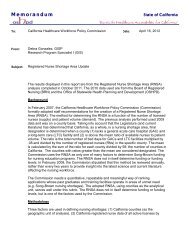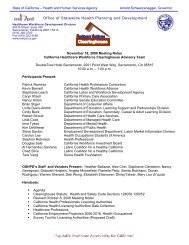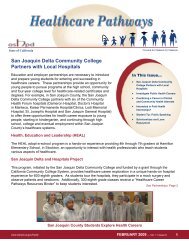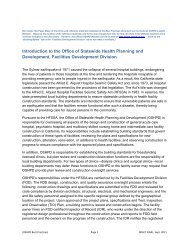Retaining Incumbent Health Care Workers - Office of Statewide ...
Retaining Incumbent Health Care Workers - Office of Statewide ...
Retaining Incumbent Health Care Workers - Office of Statewide ...
Create successful ePaper yourself
Turn your PDF publications into a flip-book with our unique Google optimized e-Paper software.
An occupational enhancement coordinator was hired for the two-year pilot program. The<br />
employers participating in the program contributed a share <strong>of</strong> the expenses for the program<br />
coordinator and core services. The goals <strong>of</strong> the pilot program include:<br />
<br />
<br />
<br />
<br />
<br />
Assisting employees with advancing within participating companies.<br />
Reduce turnover rates in participating companies.<br />
Use emergency and social supports in order to remove barriers in people’s lives that<br />
could negatively affect employment.<br />
Remain financially self-sufficient by proving to be a cost-effective means <strong>of</strong> service<br />
delivery that ultimately helps the bottom line <strong>of</strong> business while immediately helping<br />
employees.<br />
Increase number <strong>of</strong> employer companies that participate in OPEN.<br />
Please go to the following link for more information:<br />
http://www.directcareclearinghouse.org/download/OPEN%20Report%20final.pdf<br />
3. Hospital Employee Education and Training (HEET) Program – funded by the Washington<br />
State legislature to address concerns related to the shortage <strong>of</strong> qualified healthcare workers.<br />
The aim <strong>of</strong> the initiative was to address the shortage <strong>of</strong> skilled healthcare workers through the<br />
support <strong>of</strong> incumbent worker training programs developed and implemented through<br />
partnerships among labor, management, and community and technical colleges.<br />
<strong>Care</strong>er ladders within hospitals provide workers with an opportunity to move out <strong>of</strong> entry-level<br />
jobs into better jobs with higher salaries. Having a career ladder and promoting from within<br />
helps employers recruit employees who want to advance, and it helps workforce retention.<br />
Turnover among recent graduates hired by hospitals is the highest in the first two years and is<br />
costly and disruptive to the organization. According to one recent study, every percentage point<br />
increase in nurse turnover costs the average hospital $300,000 per year, and hospitals that<br />
have high nurse turnover spend about $3.6 million more than hospitals that have high retention<br />
<strong>of</strong> nurses.<br />
The current nursing workforce does not reflect the diversity <strong>of</strong> the U.S. population; men and<br />
Hispanics are especially underrepresented. This is in contrast to the lower-skilled job<br />
classifications in hospitals that have higher numbers <strong>of</strong> ethnic and racial minorities. Increasing<br />
access to nursing programs for incumbents with less skills who are currently working in<br />
hospitals is an effective means to increase the size and diversity <strong>of</strong> the nursing workforce.<br />
There is also an urgent need to provide viable pathways for incumbent workers in rural hospitals<br />
to become nurses without having to quit their jobs and relocate to larger communities or travel<br />
long distances in order to attend existing nursing programs. Educating local incumbent workers<br />
in rural communities provides skills to individuals who already have demonstrated a willingness<br />
to live and work in those communities.<br />
The colleges provided the instruction, adapting course delivery to the worksites. The colleges<br />
were the fiscal agents for the projects, providing administrative support for the funds. In three<br />
cases, the labor-management partnerships worked together to provide tuition assistance and<br />
space for classrooms. They also managed the worker-learner schedules to facilitate the<br />
maximum worker participation in the program as well as “wrap-around” support services to the<br />
worker learners. In the Puget Sound area programs, the grants funded a shared labormanagement<br />
coordinator who facilitated the communication between various partners, as well<br />
2
















